Honryu Tenkara
You hear this all the time “Tenkara is OK for small streams, but it wouldn’t work on my river”. Or the classic “Tenkara is OK for tiny trout, but not the fish I catch”. Well, I don’t know about you, but a 20-inch Sea-run fish in flows strong enough to knock you off our feet in a river 50 to 100 yards wide counts as “Not a tiny fish” and “Not a small stream”. Welcome to just one part of the world of Honryu Tenkara
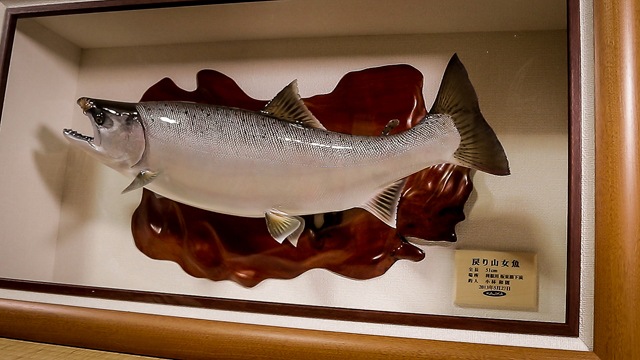
Contents: Click the Quick Links Below to Skip to Article Sections
Honryu Tenkara Techniques (with Rig Diagrams)
The Wonderful Fish of Honryu Tenkara
What does Honryu Mean?
Broadly translated “Honryu” (or technically “Honryū” or “Honryuu” with the longer “u” sound) means “Main Flow” or “Main River”. In Japan, the distance from mountain-top to sea is relatively short and before the largest rivers reach the flat plain/estuary areas (and while they are still recognisably in the mountains and foothills), they are commonly known as Honryu.
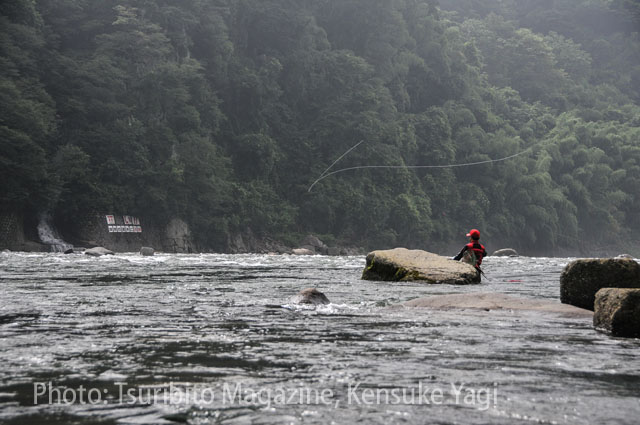
They are incredibly powerful rivers and, under normal conditions, flow clear and blue – with lots of white water around the huge boulders. Of course, there is quite a lot of variation in size – but a general feature is that they combine the flows of multiple “keiryu” rivers (the “regular”, medium-sized mountain rivers”) as their tributaries.
Honryu Tenkara Background
Over the last 20 years or so, a growing group of tenkara anglers has been developing and refining approaches to fishing in these intimidating rivers. Honryu tenkara is now a recognised branch of angling in the Japanese fishing media – and probably the most famous exponent is Kazunori Kobayashi. Here’s some privileged access to personal insights into his success on these waters:
Kobayashi-san’s skills were showcased in the 2013 Tsuribito DVD production “Honryu ‘Shaku-Plus’ Tenkara” (where “shaku” is the prized 30.3 cm length of a specimen fish – whose status and importance were brilliantly captured by Rolf Nylinder in his short film “The Great Shaku Hunter”). The Tsuribito DVD featuring Kobayashi-san was, therefore, about tenkara fishing in Honryu settings for specimen fish – including sea-run trout and char.
Honryu tenkara fishing is not only for sea-run fish. The fittest, hardest fighting and largest resident amago and yamame also tend to be caught from honryu settings. Big, resident iwana are on the cards – but that opportunity is not confined to honryu reaches. Iwana’s ability to live a long time and to keep pressing on upstream higher than yamame and amago means that an individual can reach a really big size in headwaters as well. There’s more on the fish of honryu tenkara at the end of this article.
Top Honryu Tenkara Anglers in Japan
As well as Kobayashi-san (who we fished with in 2017), we have been fortunate to meet many very accomplished honryu tenkara anglers. The human fishing database “Ajari” – or Kazumi Saigo and Yoshiyuki Mushu (one of the infamous “Tenkara Acrobats” gang who have collectively pushed the technical standards of Japanese tenkara) are both incredibly successful practitioners of honryu tenkara.
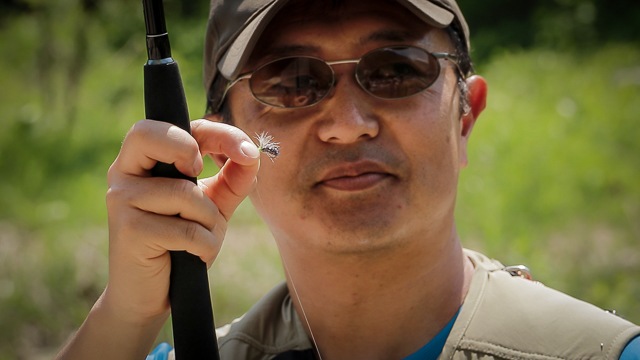
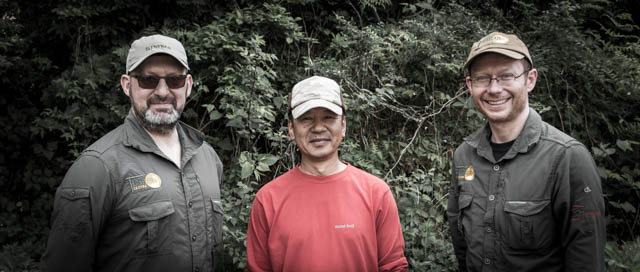
Kazuo Kurahashi, Go Ishii and Dr Ishigaki all practice and exchange knowledge on this branch of fishing and Masami Sakakibara has dedicated many years to develop his honryu tenkara skillset.
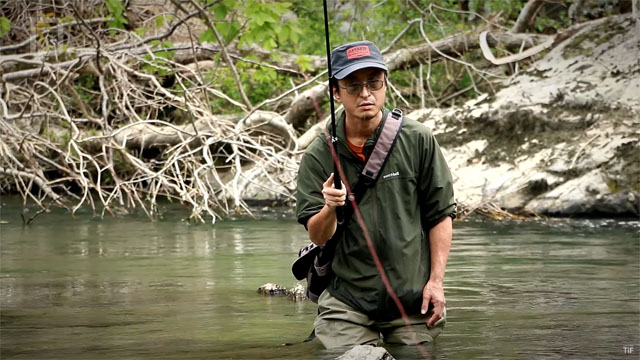
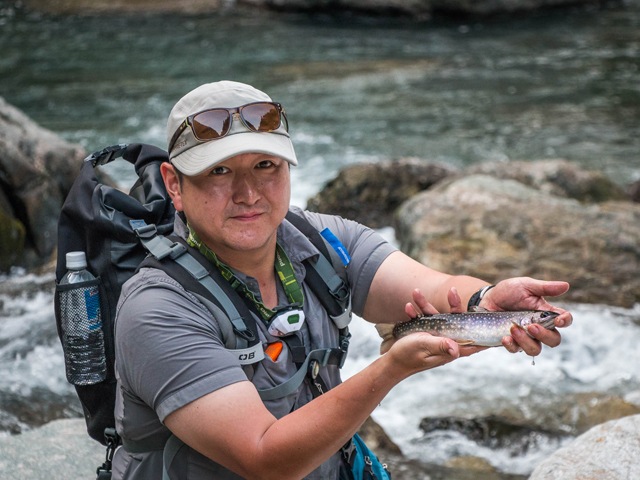

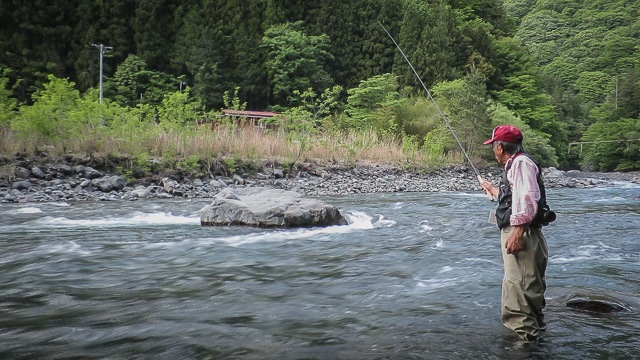
Bringing in the professional angle, Hirata-san of Shiro-Tori in Gifu also has highly developed honryu tenkara skills (part of his secret to reliably catching the largest and most beautiful amago in his region).
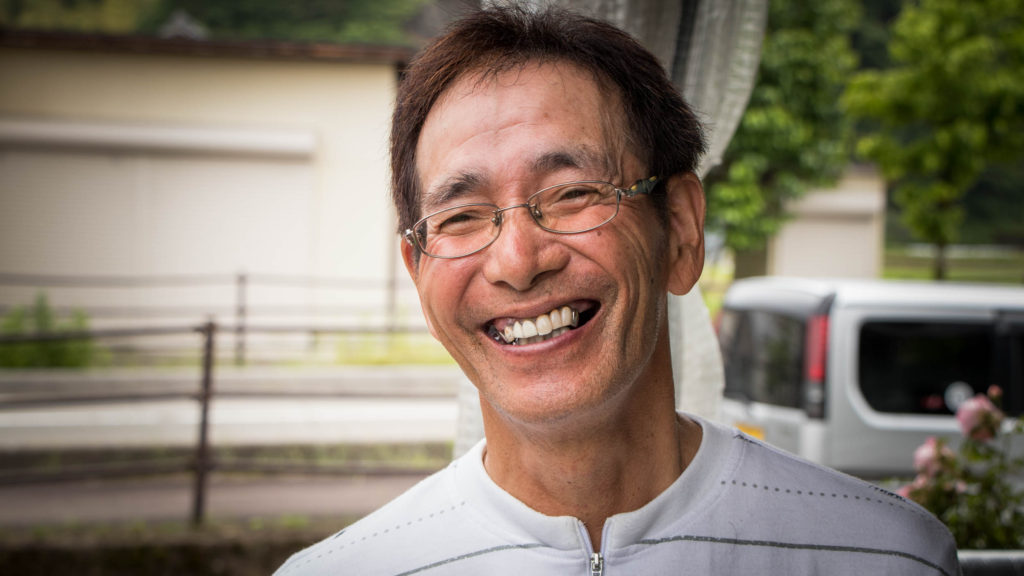
Collectively, tenkara anglers who have been targeting honryu have adapted the tackle and the techniques of regular “keiryu tenkara” to meet the challenge of these intimidating rivers and fish.
It is important to remember that a fish doesn’t even need to be particularly large before it becomes a real challenge in the powerful flows (something that needs to be experienced to be believed)…
Honryu Tenkara Tackle: Spotlight on Rods and Lines
As we’ll see in the “techniques” section, there are a few different approaches to catching fish on tenkara gear in honryu settings. These differences arise for a number of reasons including:
- Styles and personalities of the angler
- Size and type of fish
- Size and power of the river
- Conditions on the day
Naturally, each different approach is best matched to particular tackle and rigs – so there is some variety in the preferred tackle depending on the situation. There are some features that are usually pretty consistent though
Common Honryu Tenkara Tackle Features
- Longer Rods – typically in the 4m to 5m range
- Longer Casting Lines – 5m to 8m is usual but up to 12m are used (while 6m is a very common length)
- Longer Tippets – 1.2m to 2m (depending on the tactics as we’ll see; with 1.5m a common length)
- Bigger/More Heavily-dressed Flies – this is not always true, but as a general guide it is a good starting point
Now let’s look at some of the basic features of the more specialised tackle (specific rigs will be given in the “techniques” section).
Big Fish – Especially Sea-runs
Kobayashi-san’s speciality style of fishing – especially in the terrifying Tonegawa river. His approach demands special tackle and, because he is a professional gear tester for Gamakatsu, he had major design/performance input into the rods he uses.
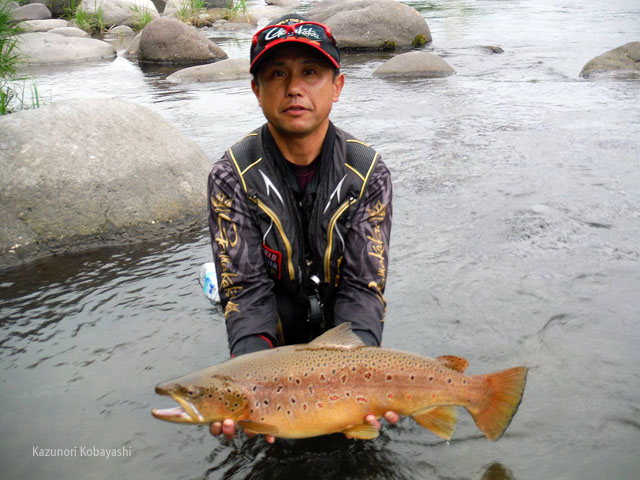
The Gamakatsu tenkara rods are exceptionally high quality and, as well as being beautiful to cast, they are extremely strong. His most used Honryu rods are a triple zoom Gamakatsu “Suimu – Tenkara Multiflex” which locks at 3.5, 4.0 and 4.5 metre lengths – plus the same rod but in a dual zoom model that locks at 4.5 and 5.0 metres.
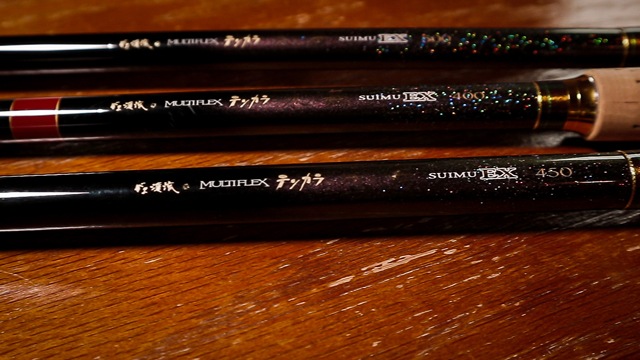
On this rod, Kobayashi-san has landed rainbow trout up to 71 cm!
Gamakatsu honryu rods are very powerful as you bend them more. You should not cast them with your finger pointing up the back of the rod – because of the leverage from the powerful lower sections and the overall length of the rod.
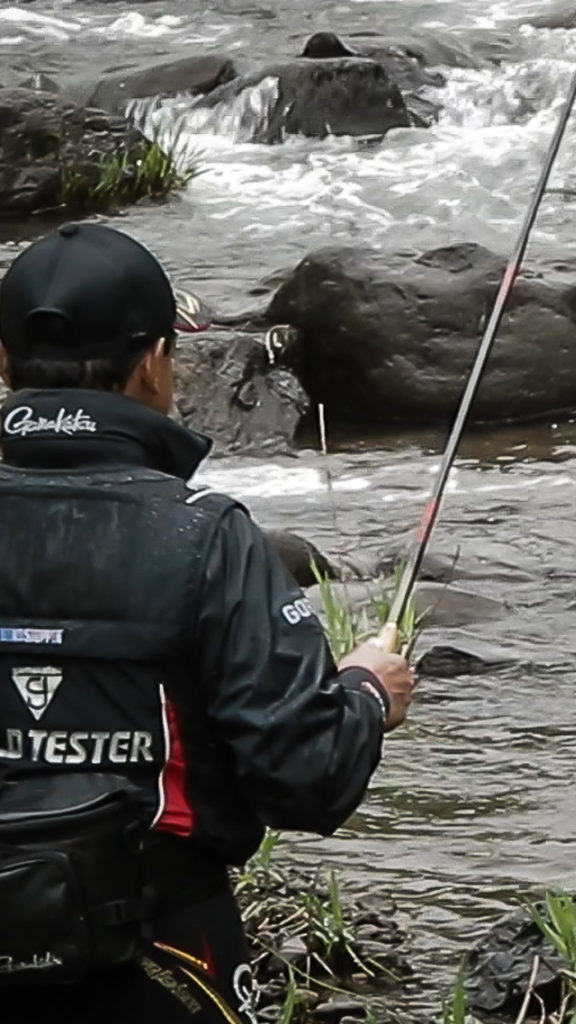
Kobayashi-san has stockpiled a lot of a specific – and now discontinued – model of furled fine nylon tapered casting line. The most common lengths he uses in honryu settings are between 8 and 10m.
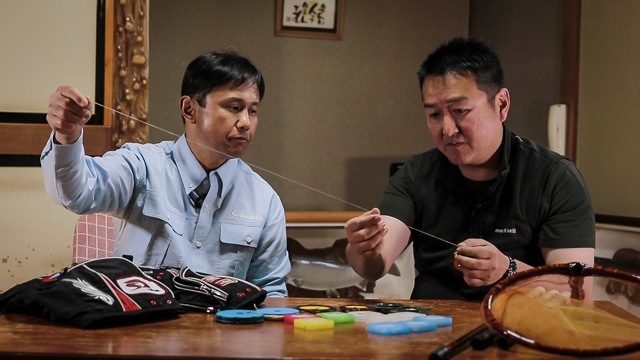
Interestingly for the foreign (outside Japan) market, Dr Ishigaki has designed a 4.4-m Shimano honryu rod (the 44 NP) that is intended for larger brown trout found in America and Europe – it has a much stiffer tip than usual for his keiryu tenkara rods (I think to help hook-sets on the relatively hard mouths of brown trout) though it also has the characteristic extremely “full flex” profile that he prefers. Chris Stewart at TenkaraBum carries these rods at the time of writing (no commission associated with this statement).
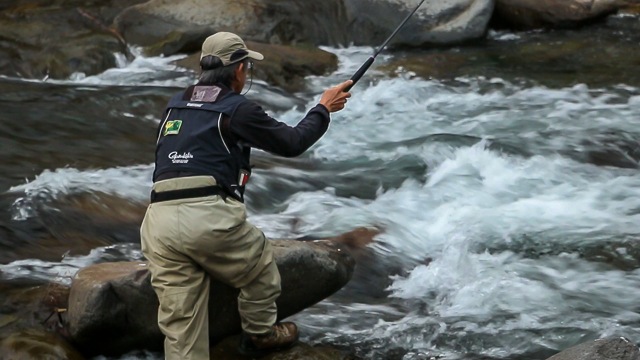
Masami Sakakibara makes a similar offering to fishing markets outside Japan with his input into the Nissin Zerosum Oni Tenkara 395 and 450 models (which measure 3.95 and 4.5 metres respectively). The best bet for anglers in America to try these rods is either direct from the Oni-shop site in Japan or through Keiichi at tenkaraya.com. For Europe, hit up Christophe at tenkarastyle.com (again no commission applies to any of those mentions).
Light line/full flex for resident fish in honryu
This is probably the gear that you’re most likely to find Ajari, Kura-san and Go using. The favourite rod (with cult status) is the now discontinued Daiwa Rinfu at a length of 4.5m (a very supple/full-flex fixed-line keiryu bait fishing rod). You had to add your own handle to this rod to create the correct balance, stiffness (yes, the handle affects this too!) and comfort for repetitive tenkara fly-casting. Here is a rare example of Jun Yossy fishing tenkara (he is normally filming! Definitely check out Yossy-san’s Youtube Channel for your fixes of Japanese fishing trips):
That supple rod is excellent for casting light fluorocarbon level lines in the Japanese #2 to #2.5 bracket. It is also the perfect tool for Kura-san’s notorious #3 level nylon tactics for “no breeze” conditions). An average casting line length would be in the 5 to 6-m range (with 6-m being the most common for #3 nylon).
The great advantage here is the ability to use the long rod to hold the light line off the water at considerable range across the powerful honryu currents.
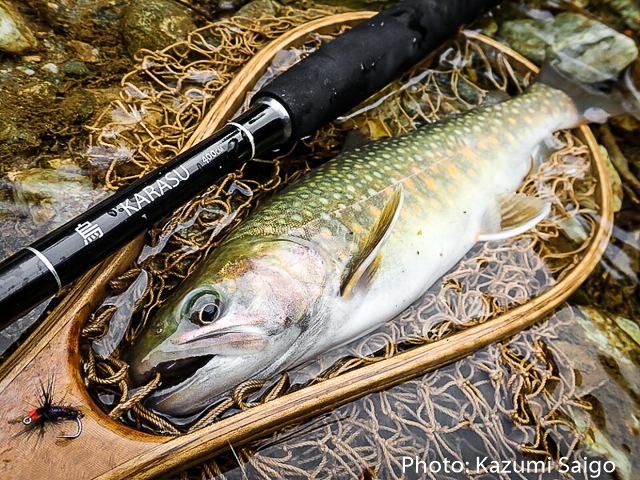
Don’t be fooled into thinking that these softer rods are no good for larger fish – Ajari (Saigo-san) routinely lands 40 to 50-cm rainbow trout from stocked areas of honryu fisheries:
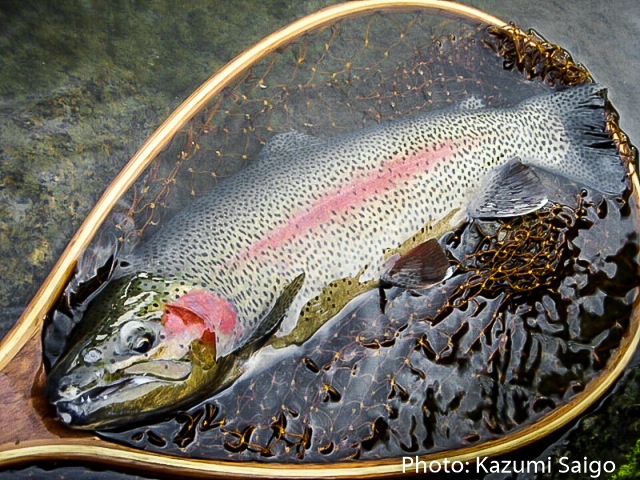
The great flex (along with the construction strength) provides a perfect cushion for fighting larger fish. It also tends to reduce the instinct of the fish to panic and streak off like a stabbed rat while you play them.
Long line/big fly for resident iwana, amago and yamame
As you’ll see there is a strong crossover with the previous category (and anglers are free to flip between different setups on different days according to conditions or just what they fancy) – but it is still worth showcasing a third style of setup here. The main difference is the common use of thicker casting line.
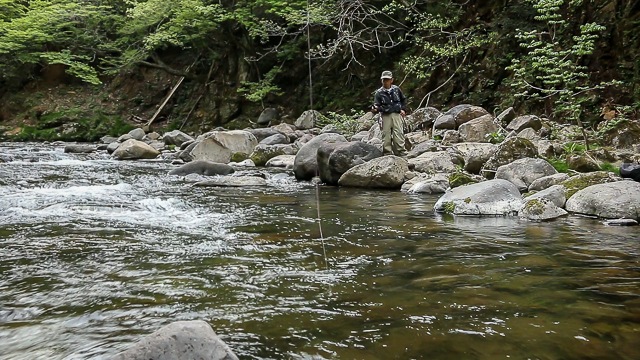
This style of setup is something I particularly associate with Masami Sakakibara and Yoshiyuki Mushu – the use of large hen-pheasant-hackled flies with black dubbing bodies and long fluorocarbon level casting lines in the Japanese #3 to #4.5 range. These are cast with wonderful loops (often at considerable range) and then the large, mobile fly worked and animated expertly to draw strikes from beautiful wild, resident fish. It was watching Mushu san fishing in this style that inspired the “The Master and The Stoneflies” article in Tenkara Angler Magazine.
Mushu-san often uses Shimano and Tenryu “keiryu tenkara” style rods – as well as other brands including Nabeya, (and typically in the longer length bracket for those rods), which often have characteristic full-flex profiles. Sakakibara-san favours his Type II Oni rod (4.0m long and a 5:5/through-action flex) for this style of fishing. All these flexible rods load up with a deep bend and launch a long line smoothly if you are an excellent caster.
Generally, Sakakibara-san uses level fluorocarbon (and that is always true when he is fishing his large kebari more deeply below the surface). If he wants to fish that fly at long range and on/very close to the surface, he sometimes opts for a long Fujino tapered nylon line (up to 12m long, but typically 8 to 10m). However, if it is windy, he will tend to favour the fluorocarbon line even for fishing at/near the surface.
Honryu Tenkara Techniques (Matched to Rigs)
Kobayashi-style Honryu Tenkara
As mentioned already, Kobayashi-san uses his highly-specialist/custom-designed Gamakatsu honryu rods, paired with a long (furled) nylon tapered line. Let’s look at a standard rig for him:
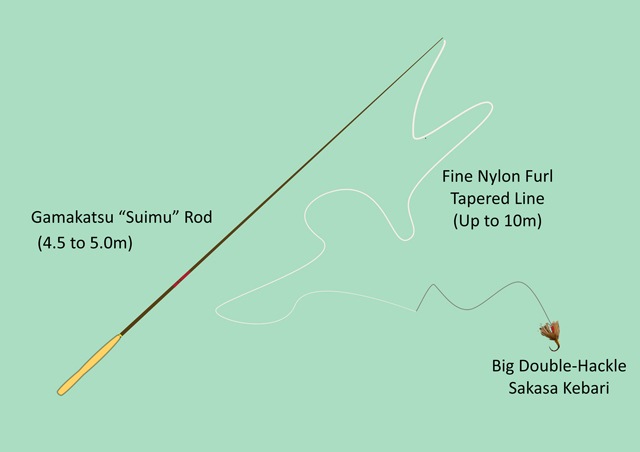
Kobayashi-san’s main Honryu Tenkara Rig
Kobayashi Honryu Tenkara Kebari
His kebari for honryu fishing is large and very heavily hackled (Kobayashi-san uses two hen pheasant breast feathers to hackle each fly). Because he is often fishing for sea-run fish, his tippet is typically around or just under 8lb breaking strain – much stronger than what is generally fished or recommended in western tenkara circles.

Kobayashi Honryu Tenkara Line & Tippet
The casting line will average around 8m in length and his tippet is between 1.5 and (exceptionally) 2.0m long and will be either #1.2 or #1.5 on the Japanese line-diameter scale (the same scale used to grade level casting-line diameters as shown on the table on this link).
Kobayashi Honryu Wading
One of the key things to realise with Kobayashi-san’s style of honryu tenkara is that the sections of river he fishes are WAY too fast to wade and cast upstream. He has to face downstream and, if he moves, that movement needs to be in a half-controlled downstream fall/walking on the moon bounce and step.
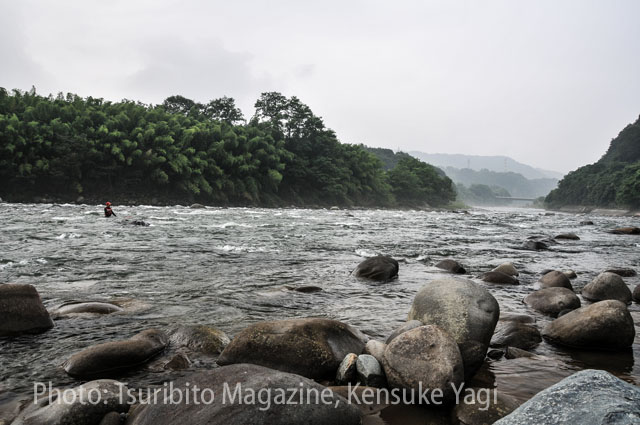
This is why, for wading gear, he chooses the wetsuit and super-durable/grippy boots favoured by hardcore ayu anglers in Japan. Normal wet-wading gear would leave you hypothermic pretty fast and waders would quickly fill with water AND – more importantly – are far too loose fitting. That loose nature creates deadly drag in the water – acting like a sail and making it impossible to keep your feet in real honryu flows. Instead, the skin-tight and absolutely streamlined neoprene bodysuit acts to insulate against cold, provides streamlined/low-drag profile and also protects your limbs and body from the inevitable bumps and bangs on the mid-river boulders. It is life or death stuff.
Honryu Tenkara Tactics (Kobayashi/Tonegawa River Style)
Presentation
Kobayashi-san’s favourite presentations are just gently and slowly “luring” the big sakasa kebari (reverse-hackle fly) on the surface of the water after casting downstream. Keeping his rod high means that the casting line is held off the water (where it cannot scare fish) and the downstream presentation and broken water make the strong tippet less important. The first thing that a fish should see is the fly – not his tippet or his casting line.
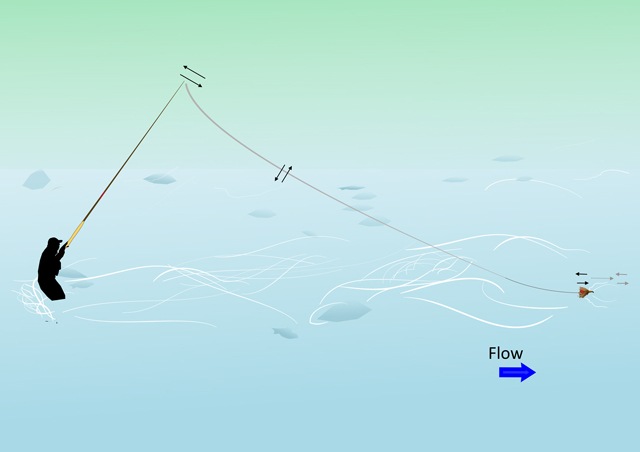
The small disturbance created and the gentle motion of the fly – seeming to be fighting a losing battle with the current – prove very attractive to the big migratory fish running the Tonegawa.
It is difficult to hook fish when fishing downstream in this manner, and this is one reason that both his luring action and the timing of his hook-set are deliberately slowed down. That takes a lot of discipline – both when fishing for long periods without response and especially at the moment when that specimen wild fish rolls on the fly.
Landing Big Fish
Kobayashi san does not rely on a netsman dashing in to snatch his fish before it has woken up to fight. As he says in his interview video, the best thing to do when hooking a large fish in heavy flow (on your own) is to try to set it in one position for as much of the fight as possible. Angling the rod over to apply controlled tension in an upstream direction is his main aim:
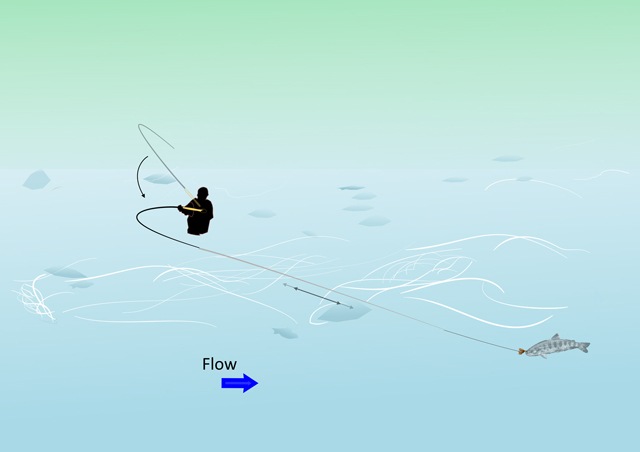
He is also keen to stress the importance of connecting your hands (and so the rod) to your body. That connection means you can use your core to fight the fish – and not only your outstretched, weaker arms.
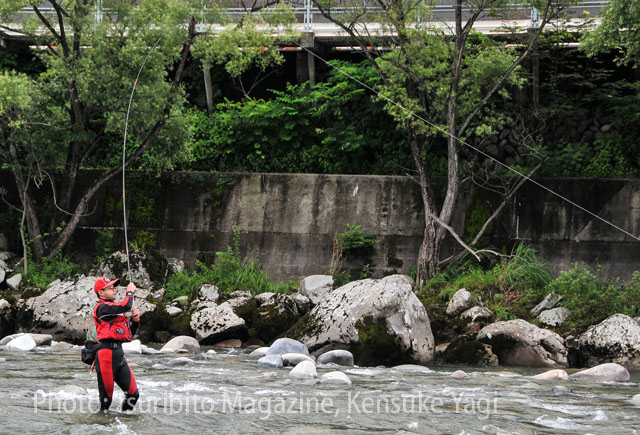
Keeping a hooked fish at range (and deliberately fishing with a longer casting line) combines the elastic stretch of your line with the bend and leverage of your rod. This allows the fight to take place with the maximum benefit from your gear.
Light Casting line/Full Flex Honryu Tenkara Tactics
Here is really the focus of what a lot of our own tenkara in the UK, Italy and even the larger keiryu streams (as well as honryu) in Japan looks like. The exception is probably our own tenkara club waters (the DT syndicate streams). Even on those small moorland streams, though, there are many open, tree-less sections that respond well to the same gear and tactics. Typical rigs look something like this:
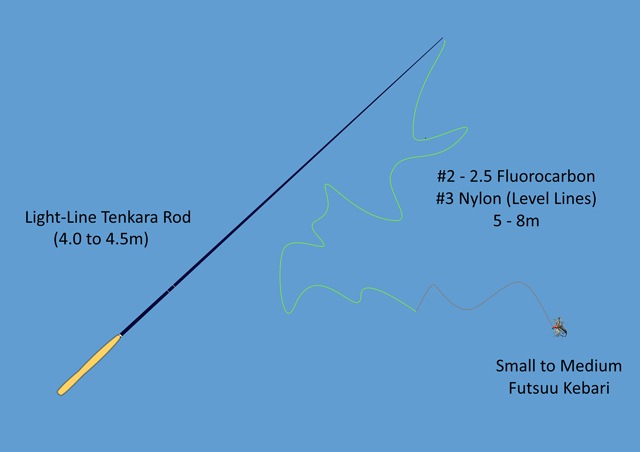
The preferred wading style here is generally “rock-hopping” – often in wet-wading gear. Having said that, folks like Mushu-san, Ishigaki-sensei, Sakakibara-san, Takahashi-san, Ajari and others do stick to the comfort of breathable waders. You won’t generally find the wet-suit/Extreme Ayu wading gear for this style of Honryu Tenkara.
Light line/small stiff-hackle kebari
The classic approach for targeting iwana in pockets – also works phenomenally well for brown trout in rivers with some broken water and gradient. So much of our content has concentrated on the rich variety of presentation skills for this approach – and it is really all about line positioning, body/casting positioning and selecting the right fly to match the conditions and application. Basically, to follow the same order as the themes above, this is laid out in the Go-Ishii bundle (line position), Kura-san bundle (casting positioning) and our book “How to Fool Fish with Simple Flies” (matching flies to conditions and pairing with the right presentation).
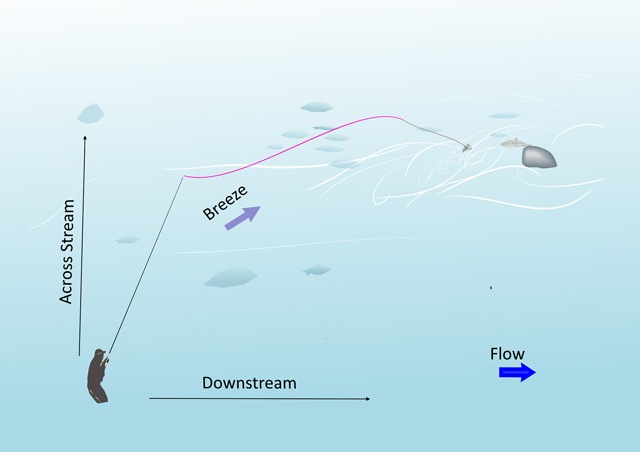
Obviously the full volume of information within those sources is too great to include here – but it is worth noting that, in Japan, casting downstream on honryu is not only a concession to flows that are too powerful to wade and fish upstream against. Whether it is to control the pace of the drift or to make sure that the fish only ever sees the fly before any of the rest of your rig, the ability to fish downstream is a major advantage. Hooking fish downstream, well – that’s another skillset again… (Hirata-san has major intel on that).
With light casting lines (and, in the right situation, the counter-acting anchor of a stiff hackle) you can really counter the effects of “drape otsuri” with these rigs and techniques. If the conditions are right for using the breeze – which is basically whenever there is a breeze and you can choose where you stand – it is easy to use casting lines up to 8m long and tippet of between 1 and 2m while holding EVERYTHING off the water up to the fly. Sometimes, you might even cast and then hold the fly off the water and dab/dap it a few times before letting it settle for a few seconds.
You see, tenkara is “sometimes” dapping – but it is far from “just dapping”
The stealth and control possible with this method also makes it absolutely ideal for the super spooky amago and yamame too – it is just that you will be targeting the feeding lanes/current tongues a little more than the small flat pockets.
Honryu Tenkara using Medium to Heavy Casting Line & Manipulations
Now we are moving into the territory I described for the level line/larger fly approaches of Mushu-san and Sakakibara-san earlier. In case it needs to be said, this style is far from the ONLY way that they fish. It is just that, if you wanted to fish in this style, you could not hope to find better examples to model.
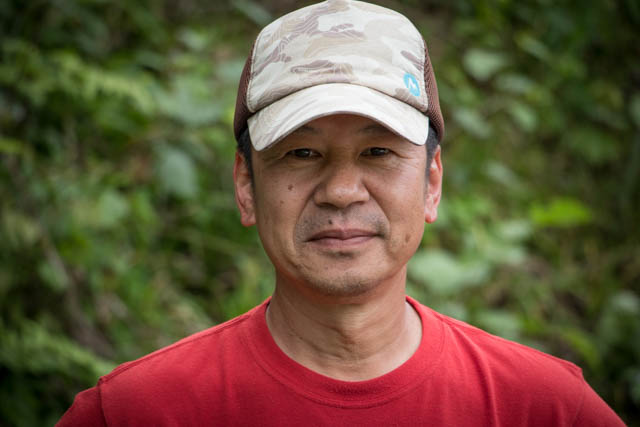
However, it is necessary to split out this category into a couple of extra sub-sections; Weighted and Unweighted kebari…
Honryu Tenkara with Weighted Kebari
This is the style that we initially received a day’s tuition in on our first visit to Japan with Dr Ishigaki in 2014. It is an approach that through exposure to Kazumi Saigo, especially, influenced a shift in Ishigaki-sensei’s fishing to include these techniques. If you aren’t familiar with Ajari’s trip reports and blog, you can see evidence of his un-matched record for consistently catching big, wild fish in Japan by checking it out here: https://ameblo.jp/tenkara-ajari/ . You’ll also see his knowledge of wild edible “sansai” foraging. It is no wonder that Ajari is the guy everybody calls when they NEED to catch fish for a magazine article and photographer (he has getting on for 15-years of incredibly detailed data recorded for all his trips compiled and carefully filed in his private database).
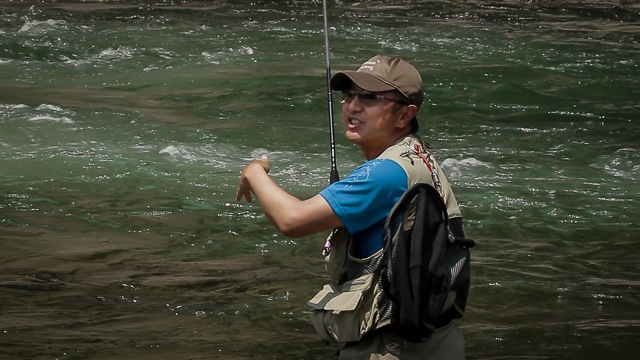
It is really effective for many of the bigger fish living in the powerful mid-channel sections of Japanese honryu whether they are large iwana, amago, yamame or even rainbow trout where they occur. Think of the kind of fish you might target in medium to large-sized rivers using a spinning rod and you’ll be in the right ballpark.
I know that there are many situations in western rivers (especially the big ones that naïve/cocky fly rodders laugh at the idea of being suitable for tenkara), that you’d like to fish a streamer on a fly rod and reel. The problem is dealing with that massive swirling upstream back-eddy or thundering current separating you from the spot you want your fly to fish. Those intervening currents grab any of your shooting line that ends up touching it – pulling your fly out of the zone straight away.
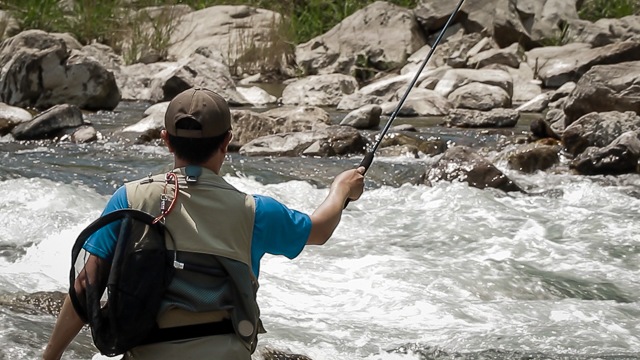
Well, with a 4.5-m rod and level casting line that can be held off the water far better than ANY fly line, it is amazing what features you can reach your fly into and fish them with great control.
With reference to the next diagram a few of the key features of this presentation style are:
- The weighted kebari (bead-head) are generally designed to fish around midwater to the lower third of the water (not really dragging the riverbed so much)
- Active pulsation/retrieving of the kebari on the fixed line is a key component (and highly skilled)
- The path of the fly will tend to be at an angle to the current (often across the main current) and the pulses of movement are designed to pull the fly in a FLAT vertical plane
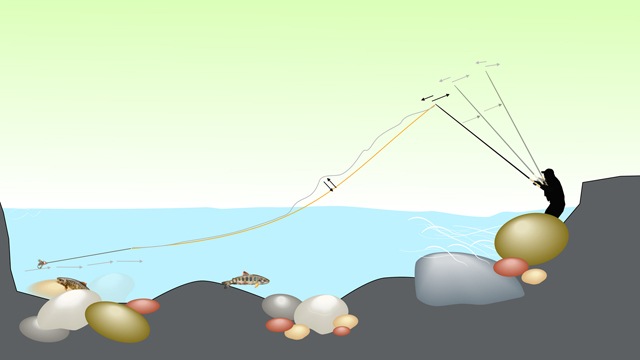
If you think of the type of movement of your fly as comparable to what you’d want a streamer to do, then you won’t go far wrong. In fact the bead-head kebari used in this style tend to resemble simple, small baitfish type patterns with bodies of thread or tape or dubbing, a collar hackle and a relatively large tungsten bead on long-shank hooks). There may be a hot-spot collar of bright/glister dubbing behind the bead also.
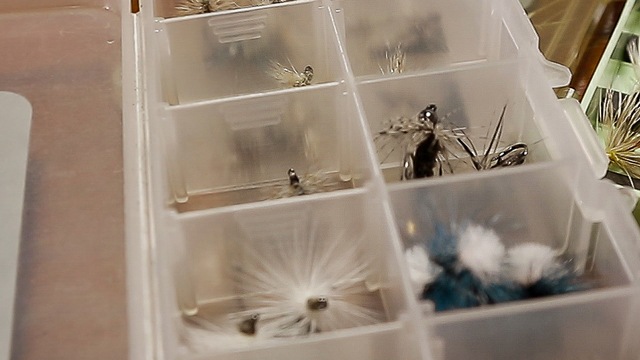
Here’s some detail on the rig:
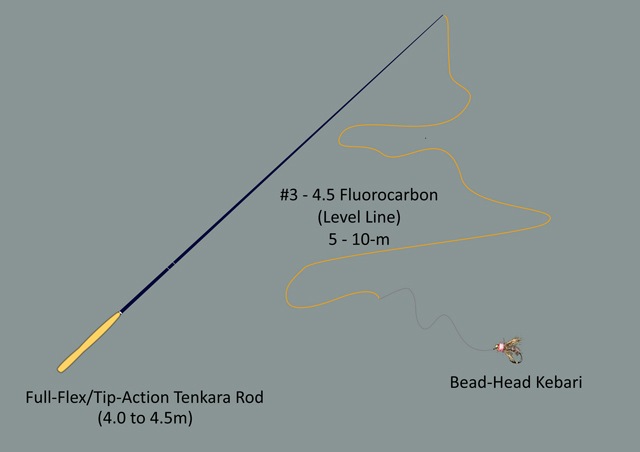
Honryu Tenkara with Large Unweighted Kebari
Some of the most masterful displays of angling that I’ve seen were by Yoshiyuki Mushu and Masami Sakakibara fishing in this style on honryu rivers in Japan. In essence, the approach is relatively simple. In many ways it is comparable to the style practiced with weighted kebari described above – only with the action raised up to either “in” or a little way below the surface. Rigs can utilise either level fluorocarbon or specialist factory-tapered nylon lines made by Fujino. Notice, again, the need for long tippets to separate the landing of the casting line from the landing of the fly/kebari. You can find more instruction on choosing tenkara tippet lengths on this link.
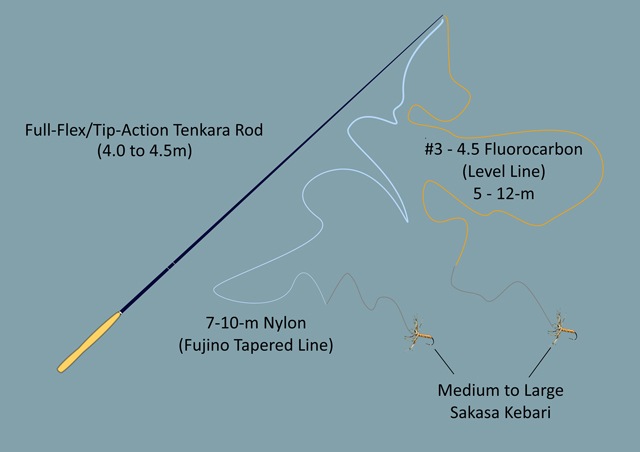
When it comes to mastering those techniques, the devil is (as always) in the detail…
Apart from the supreme casting skills – there is the positional sense and the skills of reading the river to know just where and how to place the fly (often at long range for tenkara fishing). While it is fairly easy to appreciate the skill level in the casting when you see it first-hand; it is every bit as difficult to truly control the waves of tension and slack in the line during the manipulation of the kebari.
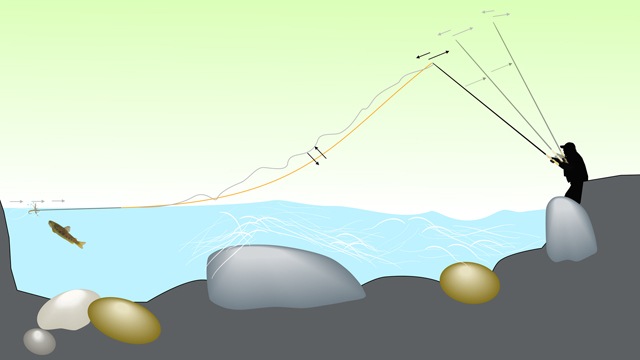
As with all tenkara (and as it should be with all fly fishing), thinking really hard about the ideal position to cast from and the angle of presentation of the fly to the fish is paramount. Seeing and understanding the different skills that exist is a huge short-cut. In the same way, learning what to look for when reading the water to try to locate fish is a massive advantage. That being said you must remember that, when it comes down to it, it takes practice to get good at all this stuff.
Reading the Water for Honryu Tenkara
The basics of reading the water for these types of river obviously have a lot in common with river fly fishing in general. Fish love structure – and anywhere that complex jumbles of rocks exist are good to focus your attention on. These can be completely submerged boulders/rocks or ones that poke out proud above the surface.
As well as their direct value as potential ambush points, boulders also create features in the currents of the river. The breaking up of the main flow and the creation of swirling/spiralling plumes of water can concentrate food as well as provide a softer flow for bigger fish to sit or hunt in.
The idea of a “feeding lane” is captured in the Japanese phrase “Kuinami” and getting good at fishing on honryu means that recognising these must become absolutely second nature. A classic example is shown in the video clip below. The slick, glassy surface that forms between the faster rips either side is what you are looking for. Then, you need to get into the detail:
The yellow oval shows a “kuinami” example. Watch the freeze-frame after 11 seconds and notice how wide the feeding lane is…Then compare to 25 seconds and beyond.
A very simple, but so easy to miss, detail that can transform your success is to realise that the value and the size of these kuinami features (particularly in honryu settings) varies over very short timescales. This means that you need to read the water for the TIMING of your cast as well as the PHYSICAL LOCATION of your cast. The cast with the best chance of success will vary during time as well as space – since (watching the clip above) you can clearly see the feeding lane “breathing” in and out.
During some rare and wonderful – moments, you can get a huge blossoming of the kuinami so that the surface becomes glassy smooth and almost stationary – and all the food concentrated in the seams is suspended ready for the fish to eat. Splatting your kebari down at that moment and making your most tempting manipulations will probably be rewarded with your biggest fish of the trip!
The actual boundary or “seam” along which the faster and slower water join is a magnet for food and predators – but I cannot repeat too often that it is a mistake to only think that you need to concentrate where to place your fly in space – on honryu venues it is very much about when also. This effect might also be apparent on keiryu streams (particularly larger ones), but the size and structure of feeding lane features tends to be a fair bit more consistent the smaller the stream gets – at least relative to the size of the fly. There is something particular about the sheer mass and volume of the rotating spirals and cylinders of water that occur in honryu settings. That size and momentum create the characteristic slow “breathing” behaviour.
The prominent “seams” between fast and slow is still obvious in this small stream – but the huge “breathing” in and out of the kuinami is absent
The magnetic effect of the seams – and the soft holding water – clearly highlighted in the yellow oval in the above video clip is really important for locating fish in this small stream. At the same time, the overall width of that soft-spot is pretty consistent over time – so this is more about being incredibly precise with your kebari placement – more than the absolutely critical timing of delivering that cast.
The Fish of Honryu Tenkara
I hope that, off the back of content like this, we might see an extending to some of the western salmonid family of the fish regularly caught using solid “honryu tenkara” tactics and gear. These tactics are most effective in the rivers with some gradient and structure where cold water flows and rheophilic (flow-loving) fish swim.
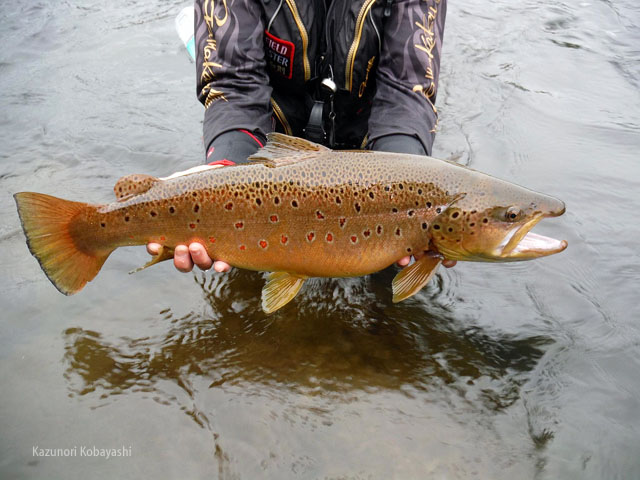
It is also good to be inspired by the iconic fish targeted by the folks who have been developing these techniques in Japan in the beautiful honryu reaches of their mountain river systems.
Honryu Amago
Resident
Amago (Oncorhynchus masou macrostomus) are the red-spotted form of the O. masou species complex and are endemic to western Japan. The specimens that do not migrate to sea may reach a likely maximum size of around 45 to maybe 50cm. Individual fish that are especially adapted to life in the powerful honryu flows often develop powerful yet streamlined deep body-shapes – the males can have a noticeable hump at the shoulder. They are distinguishable from other, resident, members of the “cherry salmon” complex by the presence of the bright red spots on the flank.
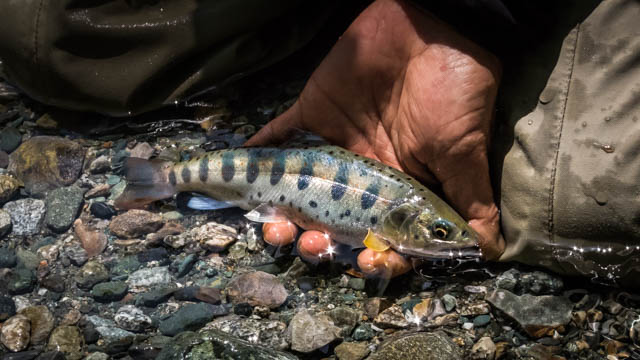
These fish are much-prized by anglers in Japan and Hisanobu Hirata is renowned for his special ability to consistently find and catch large specimens from the difficult and heavily-fished honryu sections of his local rivers in Gifu prefecture.
There is some confusing inconsistency with the scientific naming of fish within this species and subspecies complex as we’ll see…
Sea-run (Satsuki masu)
Commonly referred to as “Satsuki-masu” – literally “Rhododendron salmon”- since the flowering period in May and June matches with the upstream migration of the salmon. They are sometimes given the scientific name Oncorhynchus ishikawae (though this name is also officially used to refer to stream-resident amago living only in the Nagara river)…Further confusion arises from the use of the scientific name O. masou ishikawai to refer to resident yamame (more below). Whether or not it is possible/correct to assign the sea-run amago to a separate (sub) species from O. masou macrostomus is a difficult point to resolve.
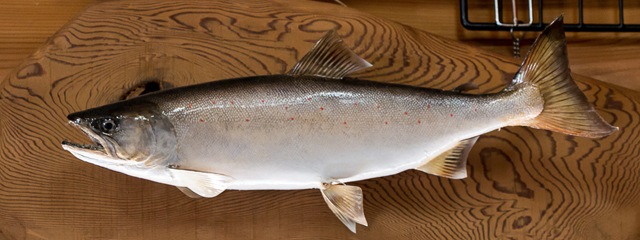
What is not controversial is the beauty and power of these “sea run amago”
Honryu Yamame
Resident
The widely-accepted scientific name for yamame, endemic to eastern Japan, is Oncorhynchus masou masou and is the originally-named (or “nominate”) species that the amago is classed as a variant of. Yamame have only black spots on their body, while amago (as described above) have both black and bright red spots.
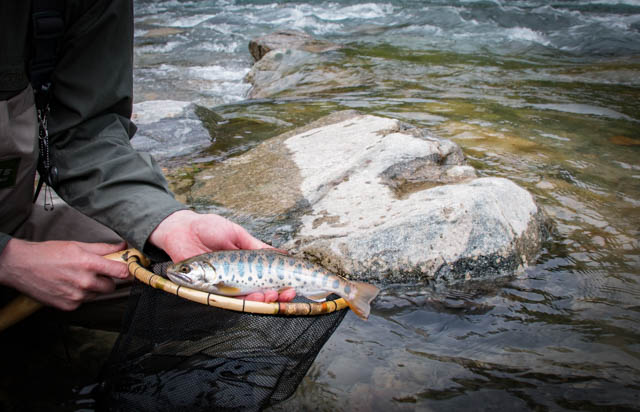
Again, as with the amago, the larger and most muscular specimens of resident yamame are almost always found in honryu settings. At the same time, in our experience, it is also common to come across roving groups of small (10 – 20-cm) yamame in honryu settings. The trick for the dedicated specimen hunter such as Kobayashi-san is to know where to find the larger fish and using flies and tactics that favour those big individuals.
Sea-run (Sakura masu)
This is the renowned “Cherry salmon” (Sakura = Cherry) and, in stern competition with Satsuki masu, is another of the most beautiful fish that swim up rivers anywhere in the world. Again, the name of the flower is included to recognise the overlap of the fish running the rivers with the blossoming of the cherry trees during Japan’s spring.
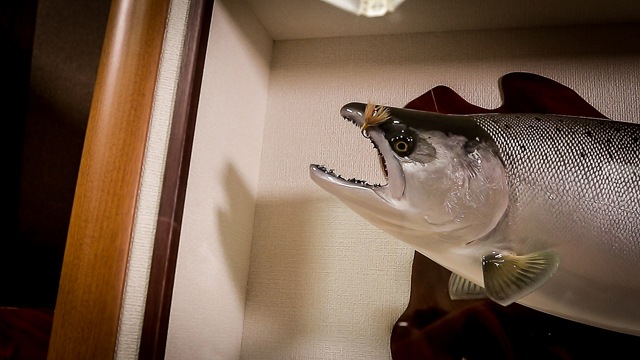
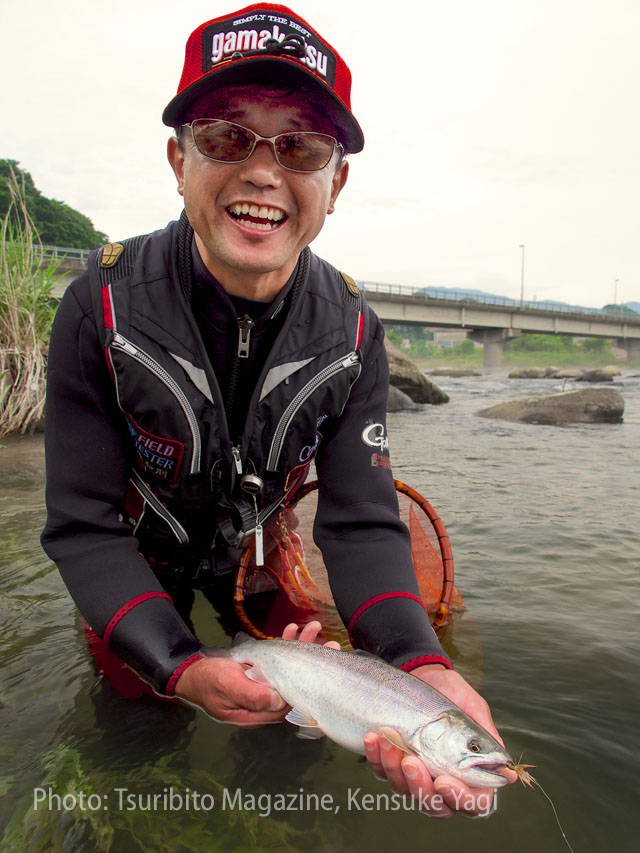
Honryu Iwana
Resident
Our trips to Japan have afforded us some wonderful memories with honryu iwana. Their range of colours and markings are constantly surprising in their beauty (much more so than we expected from photographs we’d seen before travelling to Japan).
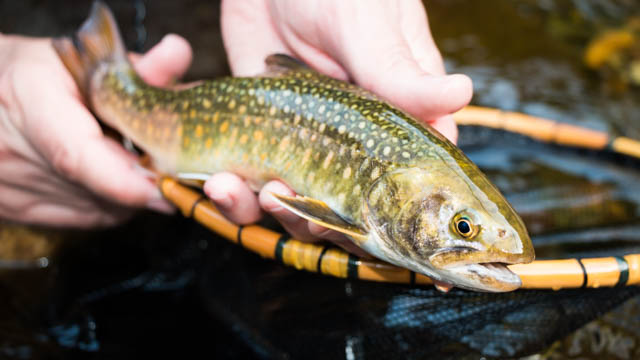
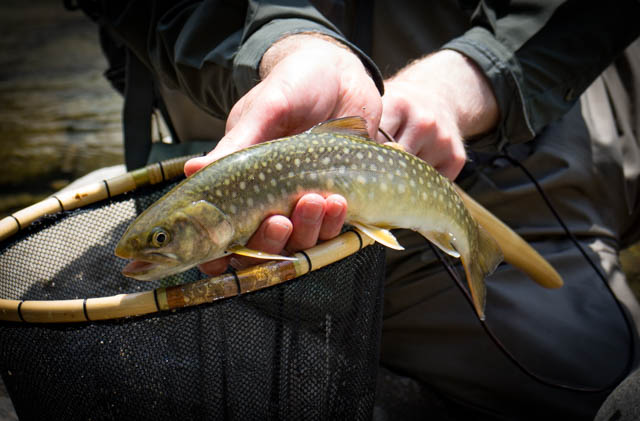
They do get much bigger than that as resident fish as well – though they are very hard to find in Japan; where fishing for the table is still the most popular form of angling. Check out Ajari’s blog for some wonderful specimens from his adventurous trips to lesser-known places.
Sea Run (amemasu)
These awesome fish used to be extremely common in rivers all across Japan. However, the expansion of the modification of river channels and extensive programme of dam and weir construction has greatly restricted their occurrence today. One area that seems to have escaped the impacts of barriers and channel modifications is in Hokkaido, the far north of Japan. As you can see from the fish caught by the fly anglers in this video, the runs of amemasu are a huge loss to anglers in the areas that they can no longer exist.
Dou you want a Masterclass from one of the anglers mentioned in this article?
Head over to our Tenkara Academy for a whole host of online courses with some of Japan’s best Tenkara anglers.
Paul
PS – If you learned anything here just now, Why not spread the love by sharing the article using the social media buttons on this page…?
We can’t create more like this without folks spreading the word…

Paul, I have always been a small river person but this article has inspired me to have a go on the Welsh Dee which is big compared to the small rivers I normally fish. Another brilliant article, I don’t know how you guys keep producing such quality items, and all for free. Thanks again for you inspiration.
Peter – I really look forward to future trip reports/photos from your forays on the Dee…
Thank you for your great feedback,
Paul
Hi there,
Do you know what size/style hook Kobayashi san uses to tie those double-hackle kebari? I’m looking to tie some up to see if Ontario/Erie steelhead like them.
Best Regards,
Sean
Hi Sean, it’s a Gamakatsu Princess Trout Hook. You can see the full tying video in the “Small Streams” bundle. We’re just in the process of creating personalised versions of the offer/sales page for that bundle so that we can advertise it more widely.
Watch this space for updates and all the best (feel free to send photos of any steelhead that take a liking to it!)
Paul
Hi Paul,
For my local steelhead streams, seems like they sit in fairly deep (at least 1.5 meter, up to 3 meters in places) water, so didnt get any takes on the double-hackle kebari.
I think I’ll try out tying up some of Ajari’s beadhead jun kebari and manipulate them through the pools. I’m going to try with a 3mm tungsten bead since it seems small enough not to mess up long distance casting with fluorocarbon (size 4.5 Sanyo Valcan).
And yes, pictures if I get any!
Sean
Sean – that would be awesome to see 🙂
Paul